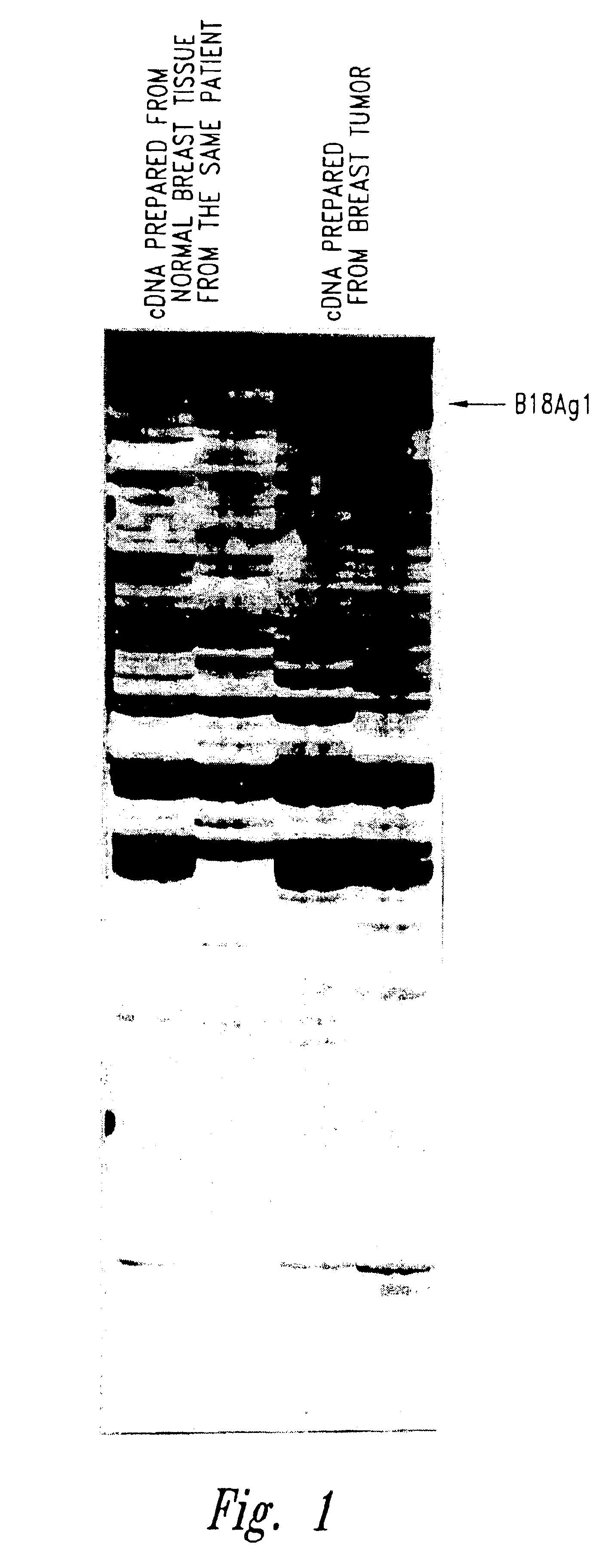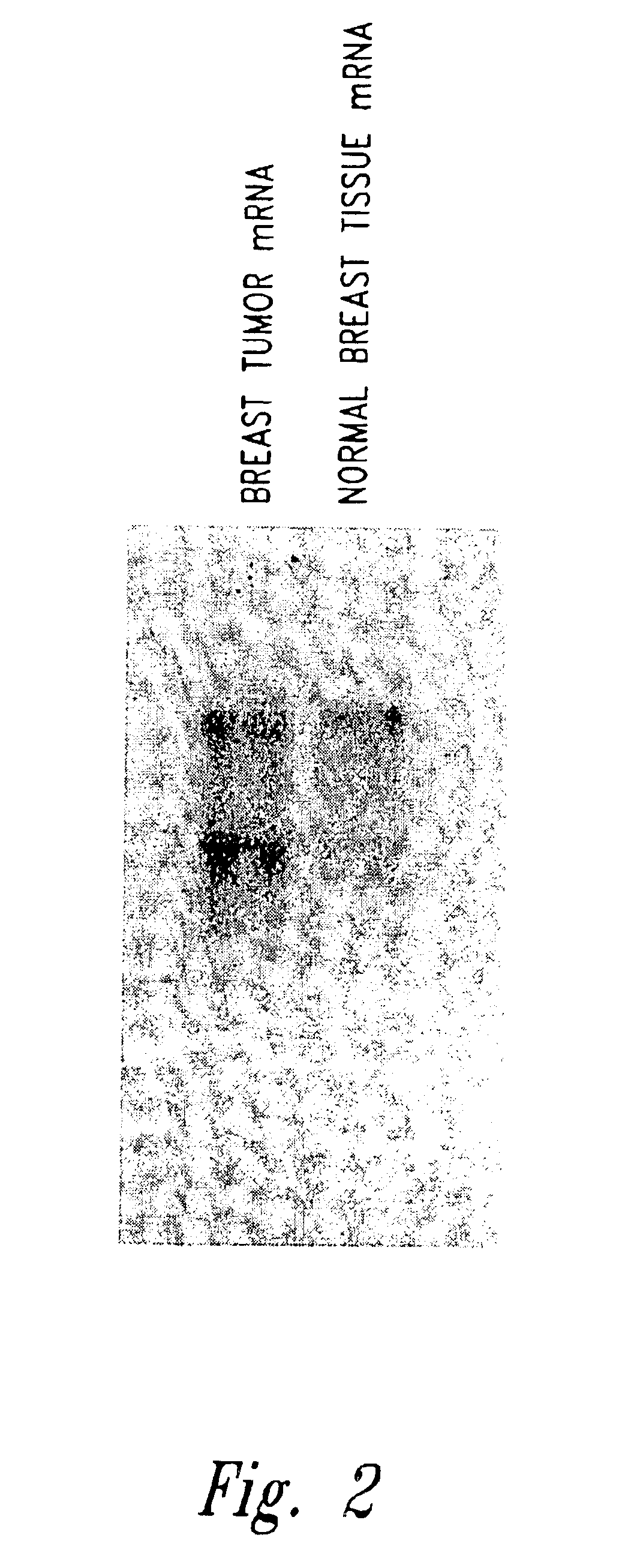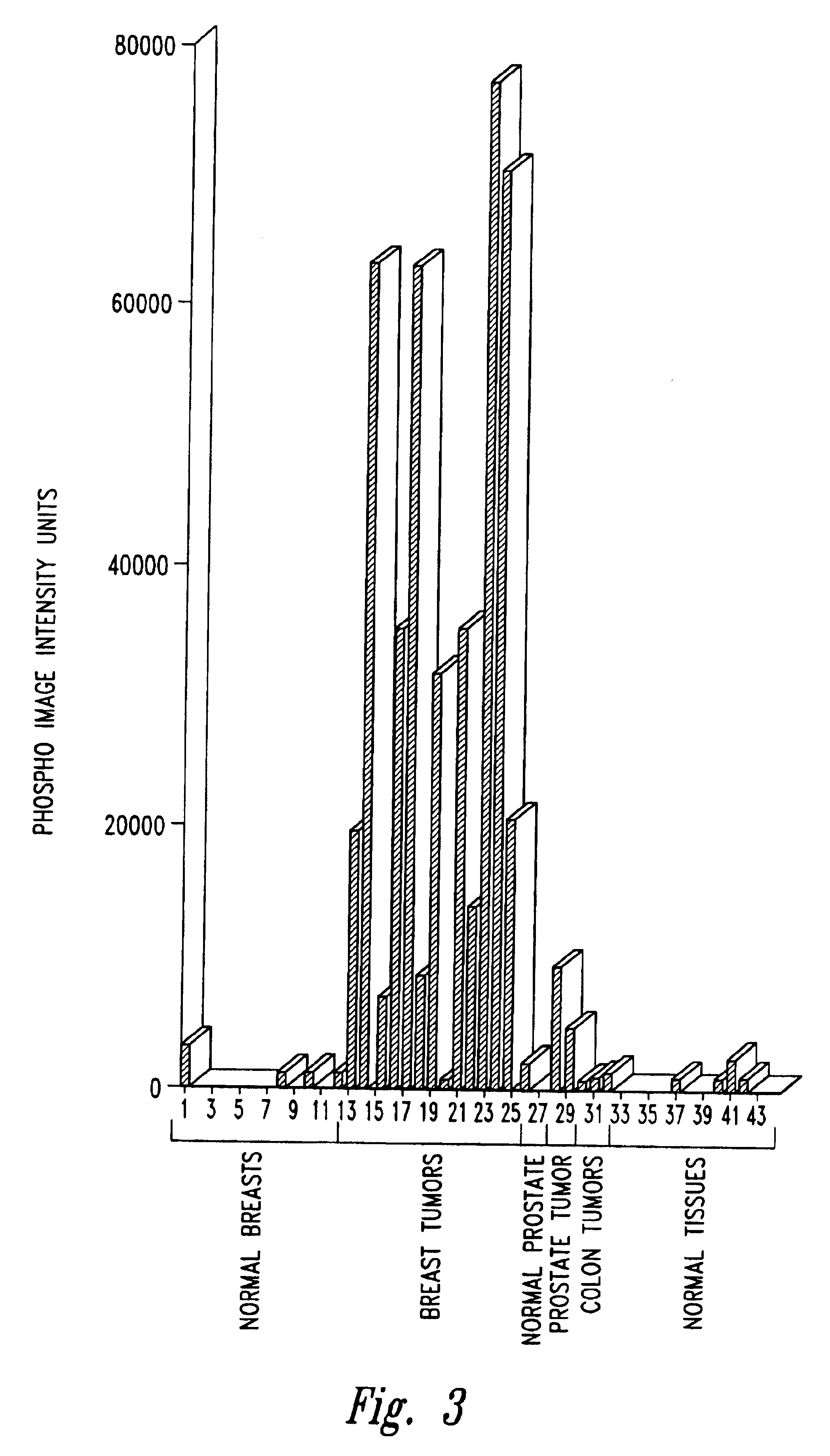Compositions and methods for the treatment and diagnosis of breast cancer
- Summary
- Abstract
- Description
- Claims
- Application Information
AI Technical Summary
Benefits of technology
Problems solved by technology
Method used
Image
Examples
example 1
[0112]Preparation of Breast Tumor-Specific cDNAs Using Differential Display RT-PCR
[0113]This Example illustrates the preparation of cDNA molecules encoding breast tumor-specific polypeptides using a differential display screen.
[0114]A. Preparation of B18Ag1 cDNA and Characterization of mRNA Expression
[0115]Tissue samples were prepared from breast tumor and normal tissue of a patient with breast cancer that was confirmed by pathology after removal from the patient. Normal RNA and tumor RNA was extracted from the samples and mRNA was isolated and converted into cDNA using a (dT)12AG (SEQ ID NO:130) anchored 3′ primer. Differential display PCR was then executed using a randomly chosen primer (CTTCAACCTC) (SEQ ID NO:103). Amplification conditions were standard buffer containing 1.5 mM MgCl2, 20 pmol of primer, 500 pmol dNTP, and 1 unit of Taq DNA polymerase (Perkin-Elmer, Branchburg, N.J.). Forty cycles of amplification were performed using 94° C. denaturation for 30 seconds, 42° C. ann...
example 2
Preparation of B18AG1 DNA from Human Genomic DNA
[0128]This Example illustrates the preparation of B18Ag1 DNA by amplification from human genomic DNA.
[0129]B18Ag1 DNA may be prepared from 250 ng human genomic DNA using 20 pmol of B18Ag1 specific primers, 500 pmol dNTPS and 1 unit of Taq DNA polymerase (Perkin Elmer, Branchburg, N.J.) using the following amplification parameters: 94° C. for 30 seconds denaturing, 30 seconds 60° C. to 42° C. touchdown annealing in 2° C. increments every two cycles and 72° C. extension for 30 seconds. The last increment (a 42° C. annealing temperature) should cycle 25 times. Primers were selected using computer analysis. Primers synthesized were B18Ag1-1, B18Ag1-2, B11Ag1-3, and B18Ag1-4. Primer pairs that may be used are 1+3, 1+4, 2+3, and 2+4.
[0130]Following gel electrophoresis, the band corresponding to B18Ag1 DNA may be excised and cloned into a suitable vector.
example 3
Preparation of B 18AG1 DNA from Breast Tumor cDNA
[0131]This Example illustrates the preparation of B18Ag1 DNA by amplification from human breast tumor cDNA.
[0132]First strand cDNA is synthesized from RNA prepared from human breast tumor tissue in a reaction mixture containing 500 ng poly A+ RNA, 200 pmol of the primer (T)12AG(i.e., TTT TTT TTT TTT AG) (SEQ ID NO: 130), IX first strand reverse transcriptase buffer, 6.7 mM DTT, 500 mmol dNTPs, and 1 unit AMV or MMLV reverse transcriptase (from any supplier, such as Gibco-BRL (Grand Island, N.Y.)) in a final volume of 30 μl. After first strand synthesis, the cDNA is diluted approximately 25 fold and 1 μl is used for amplification as described in Example 2. While some primer pairs can result in a heterogeneous population of transcripts, the primers B18Ag1-2 (5′ATG GCT ATT TTC GGG GGC TGA CA) (SEQ ID NO: 126) and B18Ag1-3 (5′CCG GTA TCT CCT CGT GGG TAT T) (SEQ ID NO: 127) yield a single 151 bp amplification product.
PUM
| Property | Measurement | Unit |
|---|---|---|
| Fraction | aaaaa | aaaaa |
| Fraction | aaaaa | aaaaa |
Abstract
Description
Claims
Application Information
 Login to View More
Login to View More - R&D
- Intellectual Property
- Life Sciences
- Materials
- Tech Scout
- Unparalleled Data Quality
- Higher Quality Content
- 60% Fewer Hallucinations
Browse by: Latest US Patents, China's latest patents, Technical Efficacy Thesaurus, Application Domain, Technology Topic, Popular Technical Reports.
© 2025 PatSnap. All rights reserved.Legal|Privacy policy|Modern Slavery Act Transparency Statement|Sitemap|About US| Contact US: help@patsnap.com



